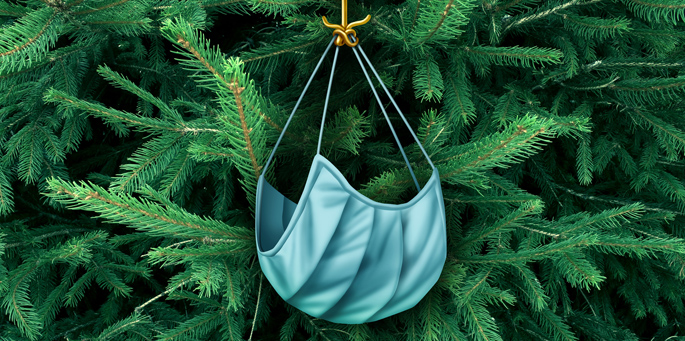
by Jill Clendening
Just as the winter holiday season is arriving, so is the new COVID-19 variant omicron, leaving many uncertain about the safest way to gather with family and friends during the ongoing pandemic.
Last year’s festivities were largely either virtual or canceled altogether, but this year declining COVID-19 cases, rising vaccination rates and the rollout of booster shots for everyone age 18 and older are combining to allow for more in-person gatherings.

Vanderbilt University Medical Center infectious disease experts advise this is the season to think very wisely about planned get-togethers. That means getting vaccinations and boosters completed before gathering, having masks ready to put on for indoor gatherings in close quarters, and making your wishes known about vaccination status and masking well in advance of welcoming holiday visitors.
“It’s very important to remember that we are safer than we were last year, because at this time last year we were just starting to immunize individuals, and people had not gotten their second dose by the time Christmas rolled around,” said infectious diseases specialist Tom Talbot, MD, professor of Medicine and chief hospital epidemiologist at VUMC. “Now we have far more people that are fully vaccinated and a significant number of people that are boosted. But we still have to remain guarded. We can’t just go all the way back to pre-pandemic, 2019 practices.”

“The best way for us to gather safely, whether now or in the upcoming holidays, is by being vaccinated,” said Buddy Creech, MD, MPH, director of the Vanderbilt Vaccine Research Program.
“And now that doesn’t just mean getting vaccinated. It means being vaccinated and boosted for those who are at least six months beyond completing a primary COVID-19 vaccination series.
“SARS-CoV-2 (the virus that causes the illness) will seek and find those who are not immune to it. We’re not going to eradicate this virus anytime soon, if ever. But what we can do is turn it from a potentially fatal virus into one that just gives us the sniffles, and the best way to do that is through vaccination.”
Creech acknowledged that the omicron variant might appear to have “thrown a wrench into everything,” but the emergence of COVID-19 variants is an expected occurrence. The delta variant is still the predominant variant and, as of now, the most concerning.
“With each new variant that pops up, we need to be prepared for a period of uncertainty where we don’t know exactly how transmissible the variant is, how severe symptoms can be, and how well our vaccines and the immunity they create will be for that particular variant,” Creech added.
Before any holiday gathering, it is perfectly reasonable to ask if another person is fully vaccinated and boosted, just as it is reasonable for that person to not answer, Creech said.
Rather than dreading a possible battle, look at it as an opportunity to have another conversation about vaccines, with a heavy helping of grace for all, he advised.
“Sometimes it’s hard to have these frank conversations with family,” Talbot said. “But if part of the family are folks who are not immunized, maybe you can say, ‘Right now, because of infection rates going up and because of our specific condition, we don’t feel comfortable with that level of risk. We still love you and want to spend holidays with you, but let’s find a way we can gather virtually this year.’ ”
If your circle includes individuals who are at higher risk for complications — such as those who are immunocompromised or elderly — ask unvaccinated individuals to keep a mask on and maintain physical distance from vulnerable persons. Or even to ask those who are unvaccinated to not attend an indoor event.
“Everyone’s going to have to make a risk calculation based on their own family dynamic,” Creech said. “We all also need to continue to pay close attention to what’s happening in the community. If disease rates are low, I get a lot less emotional about being unmasked in a roomful of people. If rates are very high, you’re going to find me in a mask most places I go.”
Families also need to think about limiting the number of indoor gatherings they attend.
“This is not the year to go to the grandparents at 8 a.m., to the cousins at noon, over to a friend’s Christmas at 2 p.m. and then to dinner with friends from out of town,” Creech said. “This is the year to have a few strategic gatherings that are smaller and hopefully comprised primarily of those who are vaccinated.”
Consider gathering outdoors or spending a portion of your time together outside. If temperatures are chilly, using a fire pit or patio heater can be an option for socializing.
And if you are indoors among attendees who might not be vaccinated, the best decision is to remain masked except for brief periods to eat or drink.
Although kids under age 5 are not yet able to be vaccinated, the fact they likely will be away from school or daycare for a period of time before holiday gatherings begin reduces risk. However, if a child develops mild cold symptoms such as a runny nose, low fever or sore throat, this is not the year to attend a holiday outing, Talbot said.
There are several at-home COVID tests now available, and while they’re not perfect, testing before gatherings, especially if even mild symptoms are present, is a good idea, he added.